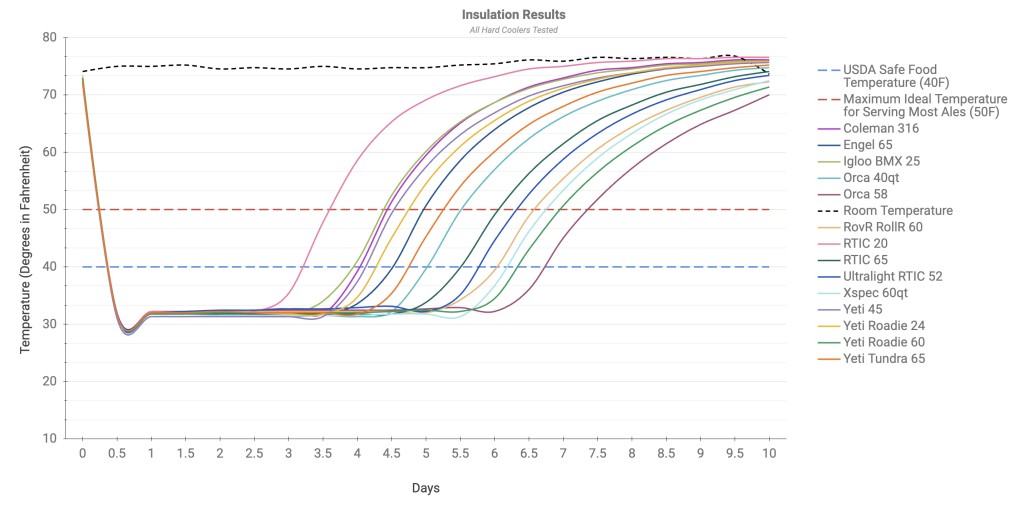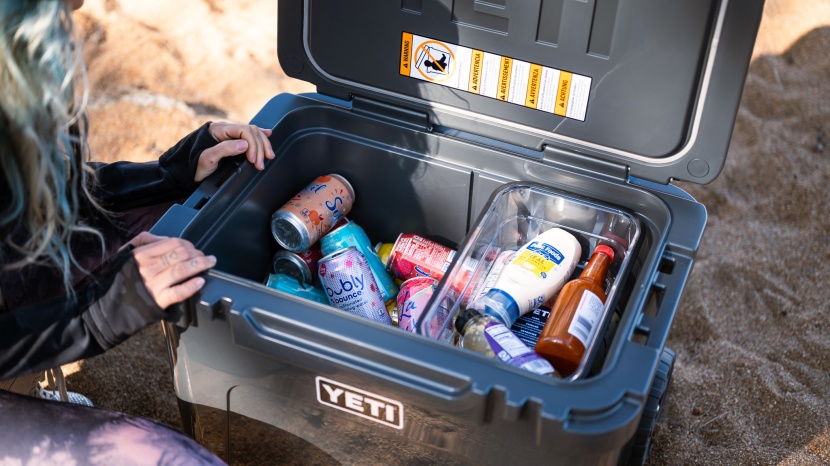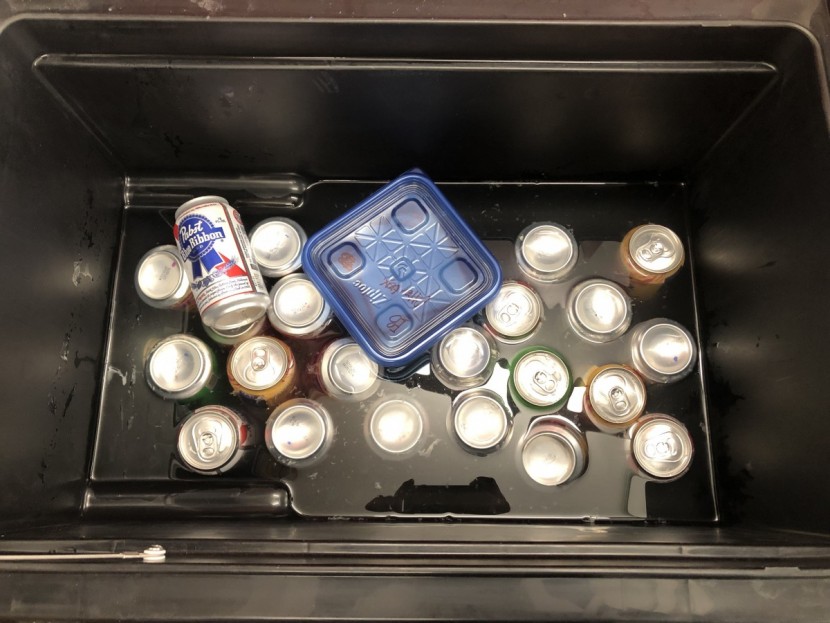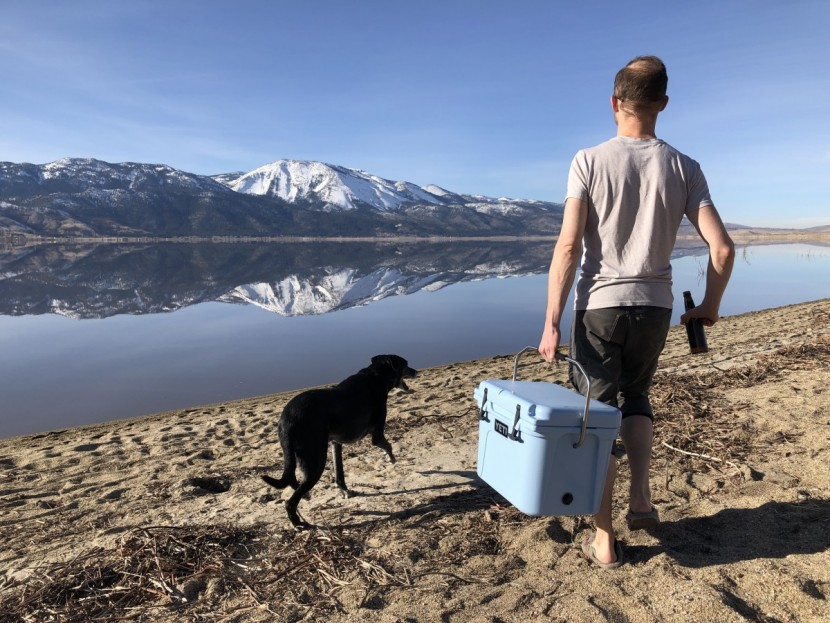The world of coolers has come a long way from the days of plastic-lined containers and Styrofoam boxes. And if manufacturer claims can be believed, portable ice chests have also grown increasingly elaborate, supposedly holding ice for up to 10 days and keeping out hungry grizzly bears. With this new, improved technology and a seemingly endless train of products parading through the online marketplace, it can be overwhelming to figure out which one will give you the performance you need at a price you're willing to pay. Over the past several years, we've spent thousands of hours continually researching and extensively testing the top models available. Rather than create unrealistic conditions to make these test pieces sound as good as a mini-fridge, we subjected them to a battery of real-life tests to see how they actually compare. Here's how we did it.
Insulation
Without question, insulation is the most important aspect of any traditional cooler. After all, if you didn't need something to keep your food and/or beverages cold, you'd just stuff them in a bag or regular box and save the cooler cash. The insulation value is so important to a cooler's value that this metric makes up half of each cooler's overall score.
Insulation also seems to be a manufacturer's favorite statistic to make claims about. Coolers come with all kinds of ice-holding claims, from five days to 10 or more. When you read the fine print of these claims, you immediately discover that the tests were run under what we think are some pretty unrealistic and unstandardized conditions. These include prechilling the cooler (sacrificing a 20 lb bag of ice 24 hours to really prep the cooler before you load it), using a 2:1 ice with food and drink ratio, always keeping it in the shade (and never in a hot car), never draining melted ice water, and only opening the cooler a few times a day when it's not as hot outside. Yeah right.
With claims so specific and restrictive, we didn't even bother testing them — because we know that most people wouldn't adhere to the requirements listed above, and neither would we. Instead, we treated these coolers like we think most people would. We grabbed some standard-sized bags of ice from the grocery store and filled each cooler up halfway with ice, then we added an iButton encased within a glass jar. This device measures ambient temperature. Though we realize that all the coolers would have benefited from prechilled contents and even more ice, we think this odd assortment better reflects how the imperfect adventurer uses them.
We recreated summertime conditions in a temperature-controlled hot room to ensure the coolers were tested in realistic conditions. We didn't open or drain these coolers during our testing, and though we realize you clearly would be opening, if not draining, them when you use them, this helped us maintain a consistently high temperature in the testing area.
After ten days, we cracked the seals and snagged testing data from our scientific sandwiches. We paid attention to two important temperature thresholds: 40º F and 50º F. 40 degrees Fahrenheit is the maximum acceptable temperature recommended by the USDA to ensure raw foods — especially raw meats — are safe for human consumption. So if you're looking to take some steaks to the picnic, have eggs for breakfast all weekend of camping, or bring burgers for the whole gang on day two, this is the important threshold.
We chose 50 degrees Fahrenheit as an indicator of your average level of beverage refreshment. Depending on your choice of drink, you may enjoy it slightly warmer (like wine) or slightly colder (lighter beers) than 50º. As different types of beers have different recommended serving temperatures, we used 50º as an average. Knowing how long you can expect chilled refreshments to stay chilled before they become hot drinks can make all the difference during your camping trip, family reunion, or backyard party.
Durability
A shocking number of the coolers we tested are certified by the Interagency Grizzly Bear Committee, and the internet seems to be full of videos of these plastic boxes standing up to bears, dynamite, enormous strongmen, and being thrown off cliffs. Instead of having our own wildlife menagerie/pyrotechnics experts/world-class bodybuilder/cliffs, we tested durability with regular humans in other, more realistic ways. We inspected every nook, cranny, and crevice of these coolers, pushing on hinges, yanking on handles, sitting and standing on lids, pulling on plugs, and picking at gaskets. We dragged them around when they were full, used them as step stools whenever they were handy, and packed them to the brim with refreshments. Likewise, we rolled them around to see how much wear and tear they could put up with.
We also filled these coolers with water and sloshed them around wildly to assess the effectiveness of the lid seal. We repeatedly opened and closed drain plugs to see which ones leaked or were too easy for the distracted user to lose. We left all the coolers to sit in the direct sunlight for several hours to see what would happen if they were forgotten during the big game or an afternoon nap. We noted how hot they felt after hours of sunbathing. Additionally, we scoured the internet for other user complaints and compared and tested the components in question.
Ease of Use
A cooler's ease of use goes a long way toward your overall experience. We tested several cooler features to assess usability, starting with the lid and latches. We tested how easily each model is opened. We also tested how easy each cooler is to load and unload, as some have lids that snap closed on your hand like a hungry hungry hippo, while others are oddly shaped inside and require specialized packing skills. We also considered the capacity of each cooler and how its size and shape play into the user experience. Some models are gigantic inside and out, while others have handles that tuck away neatly, creating a relatively small package, yet are larger within than we expected. Other coolers are long and low, facilitating an easy grab of exactly the ingredient or beverage you're looking for, while others are tall and narrow, which forces you to root around inside to find your preferred flavor of refreshment.
Additionally, we tested the external components of each cooler to see how easy they are to use. We opened and closed drain plugs and checked how easily each cooler empties (without simply opening the lid and flipping the whole thing upside down). Some models have larger drains that quickly and easily empty liquid contents. In comparison, others have smaller drains or drains located too far above the cooler floor, forcing you to hold one end up to drain the melted icebox adequately. Likewise, we noted which coolers included tethers with their drain plugs, as it would be a problem if that got lost. We also considered the usability of handles — are they easily grabbed and/or moved into carrying position or stowed away? And for coolers with wheels, we checked how those wheels packed away into a car and how the wheel wells inside affect the cooler's packability.
Portability
Clearly, larger, heavier coolers will be more difficult to cart around, especially when full. However, many other factors go into each model's relative portability score. Of course, coolers on wheels have the obvious leg up in this competition, though not all wheels are created equal. Among wheeled models, we rolled them across flat, paved parking lots and sidewalks, lawns, loose sand, and over bumpy gravel while fully loaded with snacks, drinks, and ice. We evaluated how well their wheels and clearance handled each variable surface and how frequently they rammed into the backs of our heels or felt harder than normal to control.
For unwheeled models, portability largely comes down to weight and handle comfort. We tossed these coolers into the backs of vehicles, put them high on storage shelves in the garage, and carried them from our cars to wherever we were hanging out. During all this, we carefully evaluated each cooler's handle placement vs. weight load, the comfort of each handle, and how easy (or impossible) it was for a single person to carry each cooler. We also considered how easily each cooler was lifted into a car or onto a park bench. Though we didn't do an official count of the curse words used during this process, we noted each model's relative ease of movement, or otherwise.
Additional Features
Though this metric is the lowest weighted one in our scoring, having handy features included with your cooler can make a difference to your overall experience, so we noted and tested each one. We didn't consider the presence of wheels or drains as a part of any cooler's features, as those are pretty heavily rolled into the Portability and Ease of Use scores. Instead, we focused on the frills and their usefulness. We awarded higher marks to more useful features such as the ability to hold dry ice (thereby significantly extending the shelf life of your food), internal baskets, and drain plug leashes to stop that important cap from escaping into the wilderness while your back is turned. Features that received lower scores but that we still appreciate include things such as cup holders, bottle openers, and fish measurement tools.




